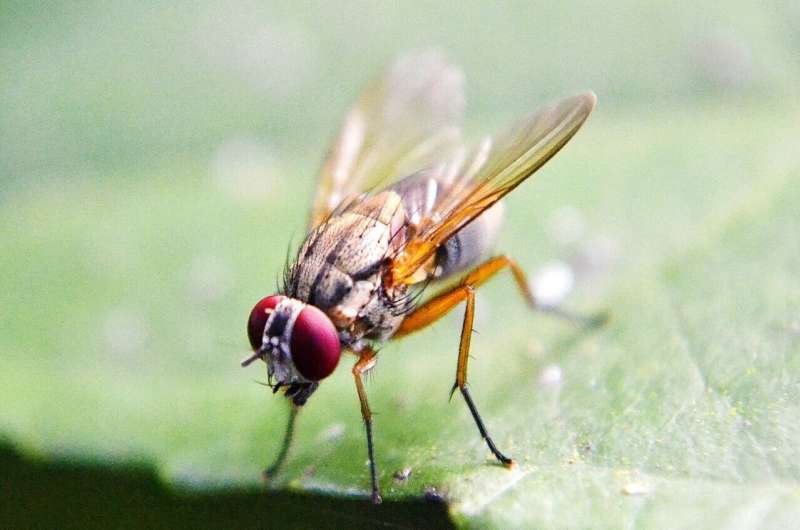This article has been reviewed according to Science X's editorial process and policies. Editors have highlighted the following attributes while ensuring the content's credibility:
fact-checked
peer-reviewed publication
trusted source
proofread
Rhythmic eating pattern preserves fruit fly muscle function under obese conditions

Obese fruit flies are the experimental subjects in a Nature Communications study of the causes of muscle function decline due to obesity. In humans, skeletal muscle plays a crucial role in metabolism, and muscle dysfunction due to human obesity can lead to insulin resistance and reduced energy levels.
Interestingly, studies in various animal models have shown that time-restricted feeding—a natural non-pharmaceutical intervention—protects against obesity, aging and circadian disruption in peripheral tissues such as skeletal muscle. However, the mechanisms underlying those benefits were not known.
In fruit flies—scientifically known as Drosophila melanogaster—obese Drosophila that are subjected to obesogenic challenges and treated with time-restricted feeding have shown improved muscle performance, reduced intramuscular fat, lowered levels of phospho-AKT and a reduction in the marker of insulin resistance. Intramyocellular lipids and triglycerides deposited within skeletal muscle cells can be harmful if not routinely depleted.
The current study, led by University of Alabama at Birmingham researcher Girish Melkani, Ph.D., provides a potential mechanistic basis for the benefits mediated by time-restricted feeding. Melkani and colleagues found that time-restricted feeding induced upregulation in genes related to glycine production and utilization, and downregulation of a key enzyme involved in triglyceride synthesis, in all time-restricted feeding conditions.
Additionally, time-restricted feeding induced upregulation in genes and increases in metabolites related to the purine cycle in the high-fat diet fruit fly model of obesity, and it led to upregulation of genes and increases in metabolites relating to glycolysis, glycogen metabolism, the tricarboxylic acid cycle and the electron transport chain connected by AMP kinase signaling, in a genetic fruit fly model of obesity mutated in sphingosine kinase, or Sk2.
"The prevalence of obesity continues to be a worldwide growing issue associated with crippling health care and economic burdens," said Melkani, an associate professor in the UAB Department of Pathology Division of Molecular and Cellular Pathology. "Obesity is associated with various comorbidities, especially high-caloric diets and genetic predisposition. This study elucidates potential mechanisms behind time-restricted feeding's protective properties against skeletal muscle dysfunction and metabolic impairment induced by obesity."
The findings may pave the way for future time-restricted feeding studies in muscle, providing a natural and affordable form of alternative therapy for managing pathologies related to metabolism and obesity, Melkani says.
Melkani also described his long-term research goals. "Recent genome-wide association studies and exon sequencing approaches have identified a linkage of additional genes with genetic obesity. Obesity is strongly linked with cardiovascular disease and dementia. However, the mechanistic linkage remains poorly understood, and urgent interventions are required to mitigate these disorders.
"Our mechanistic approach—along with interventions including time-restricted eating—will be highly useful in addressing and treating the obesity, cardiovascular disease and dementia disparities seen in the Deep South."
The fruit fly is an amenable model for studying human metabolic diseases. In the current study, the high-fat diet fruit fly model of obesity has a diet that is supplemented with 5 percent coconut oil, and the fruit flies are allowed to feed 24 hours a day. The time-restricted feeding, high-fat diet fruit flies have access to the high-fat diet only 12 hours a day. The Sk2 fly model of obesity has a mutation in the Sk2 gene, leading to a hallmark accumulation of ceramide, which is implicated as a contributor to obesity.
Experimental methods for muscle performance in the current study included flight tests where 10 to 20 fruit flies are released into a Plexiglas box, and each fly's ability to fly up, horizontally, down or not at all is measured. Methods also included cytological analysis of muscle tissue and abdomen fat bodies, gene expression analyses, and measurement of glycine, ATP and metabolite levels.
More information: Christopher Livelo et al, Time-restricted feeding promotes muscle function through purine cycle and AMPK signaling in Drosophila obesity models, Nature Communications (2023). DOI: 10.1038/s41467-023-36474-4
Journal information: Nature Communications
Provided by University of Alabama at Birmingham




















